Hybrid Team Management: Why 95% Fail & The 5-Layer Fix
Table of Contents
Bottom Line Up Front: While 72% of teams now operate in hybrid settings, a staggering 95% of employees don’t understand their company’s strategy, and 70% of managers have received zero training for hybrid team management. The result? A productivity crisis masquerading as flexibility. But there’s a systematic fix that can transform your hybrid team’s performance in 90 days.
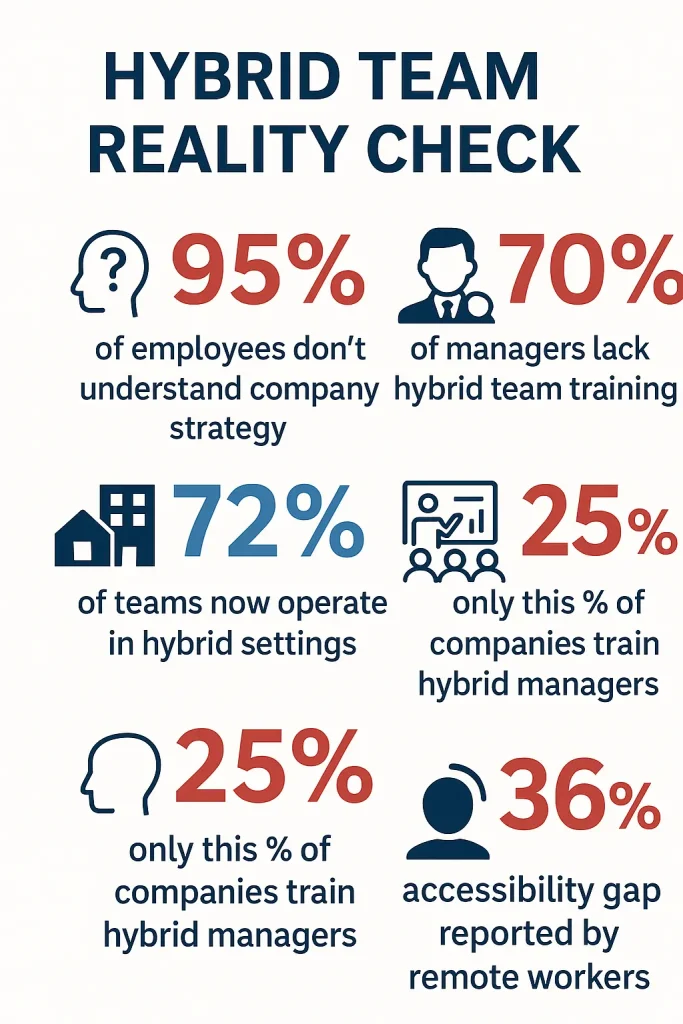
Most C-suite executives believe their hybrid teams are thriving. The data tells a different story entirely.
HYBRID TEAM REALITY CHECK
• 95% of employees don’t understand the company strategy
• 70% of managers lack hybrid team training
• 72% of teams now operate in hybrid settings
• Only 25% of companies have trained hybrid managers
• 36% less accessibility reported by remote workers
Only about one quarter of companies have trained their people managers to lead hybrid and distributed teams successfully. At the same time, employees gave their managers a mediocre 7 out of 10 on effectively managing hybrid and remote teams. Even more alarming: 30% are frustrated by unclear communication from their bosses.
Here’s what’s really happening in your organization right now.
Your hybrid teams aren’t failing because remote work doesn’t work. They’re failing because you’re using industrial-age management techniques for knowledge-age problems. And the cost? 70% of projects globally fail, with hybrid teams showing identical failure rates to their fully remote and in-office counterparts at 73.4%.
The Real Hybrid Team Crisis (It’s Not What You Think)
What is Hybrid Team Management?
Hybrid team management is the systematic approach to leading teams where some members work remotely and others work from centralized locations. Unlike remote team management (all distributed) or traditional team management (all co-located), hybrid team management addresses unique challenges, including proximity bias, communication asymmetry, and context distribution gaps.
VIEW: Forget productivity paranoia. The real crisis isn’t whether people work from home or the office. It’s that we’ve confused location flexibility with performance clarity.
The Hidden Problem: Management Architecture, Not Work Location
Most organizations approach hybrid work as a location policy rather than a management methodology. This creates what researchers call “productivity paranoia” – the anxiety leaders feel about team performance when they can’t observe direct activity.
The result is management by location rather than management by outcome. Companies implement return-to-office mandates not because office work is more productive, but because existing management systems were designed for co-located teams.
Hybrid vs. Remote vs. In-Office: The Critical Differences
| Management Approach | Communication Pattern | Performance Visibility | Coordination Method |
|---|---|---|---|
| Traditional (In-Office) | Informal + Structured | Direct observation | Spontaneous + Scheduled |
| Remote Team Management | Structured channels | Outcome-based metrics | Systematic coordination |
| Hybrid Team Management | Asymmetric channels | Mixed visibility requirements | Flexible coordination systems |
The Asymmetric Challenge:
Hybrid teams face asymmetric experiences that neither pure remote nor pure in-office teams encounter: • Information access varies by location • Relationship building opportunities are unequal
• Career advancement visibility differs based on proximity • Decision-making inclusion varies by physical presence
I’ve spent years ghostwriting educational content for B2B tech startups from seed to Series C, and I’ve witnessed this pattern repeatedly: founders who can articulate billion-dollar visions to investors struggle to create clarity for their own teams. The problem compounds exponentially in hybrid environments where casual corridor conversations disappear.
Projjal Ghatak, CEO of OnLoop, who scaled teams at Uber from 9,000 to 27,000 employees while personally managing teams of 50+ people, puts it bluntly: “95% of employees do not understand their company strategy in the first place.” Even more striking, “only 7% of employees fully understand their company’s business strategies and what’s expected of them to help achieve company goals.”
This isn’t an engagement problem. It’s an architectural problem.
The 5-Layer Framework That Actually Works
Through Projjal’s work with B2B tech companies and analysis of successful hybrid transformations, he’s identified five critical layers that separate high-performing hybrid teams from the 95% that struggle. This framework, validated by companies like OnLoop (whose Collaborative Team Development approach has helped 200-500 person companies transform their performance), provides the systematic approach most leaders lack.
5-LAYER FRAMEWORK QUICK REFERENCE
- Energy Management → Battery check system for optimal task allocation
- Strategic Clarity → Targets, projects, skills alignment cascading upward
- Strengths-Based Feedback → Superpower identification and leverage
- Targeted Improvement → Layer-specific development based on performance level
- Continuous Learning → Systematic skill building integrated into workflow

Layer 1: Energy Management (Not Time Management)
The Battery Metaphor That Changes Everything
Stop tracking hours. Start tracking energy.
Ghatak’s team discovered something profound when working with hybrid teams: “If you ask someone, are you stressed or are you tired or are you anxious? People’s natural tendency is to say no. But if you just ask someone, how full is your battery? People then quickly assess and being like, actually I’m running at 60% today.”
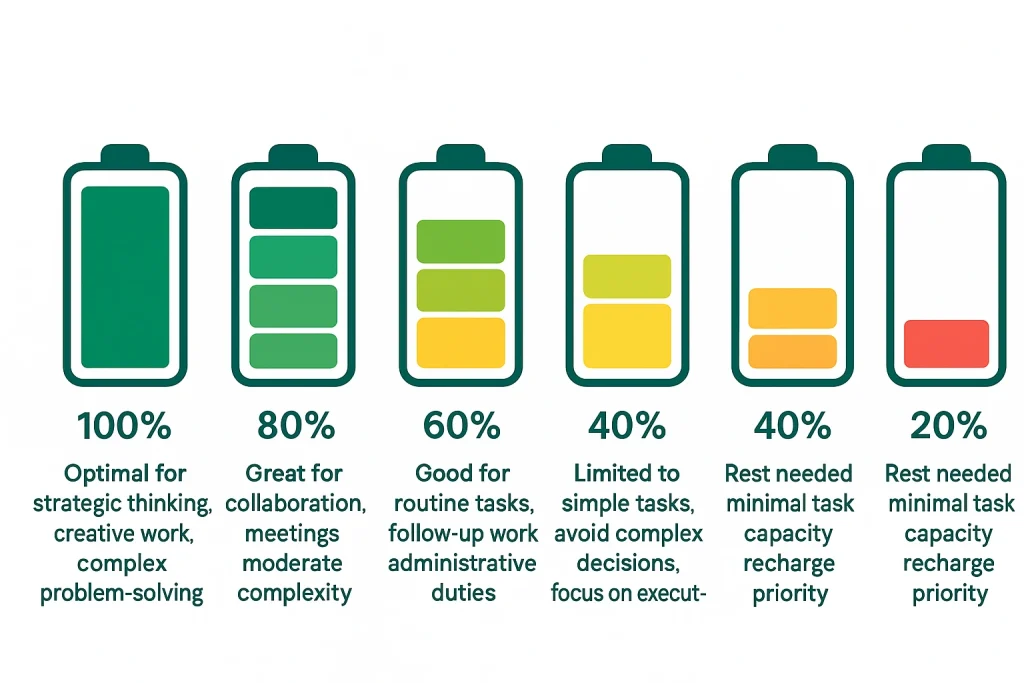
This isn’t wellness theater. It’s performance optimization.
When someone’s operating at 40% battery, they can handle flow-state tasks like strategic thinking or creative problem-solving. But complex coordination or detailed execution becomes exponentially more complicated. In hybrid environments, where you can’t read physical cues, this battery check becomes critical intelligence.
Practical Application: Begin every team interaction with a 30-second battery check. Not as small talk, but as operational data. When you know your team’s energy distribution, you can optimize task allocation and prevent the productivity crashes that plague hybrid teams.
Layer 2: Strategic Clarity (The Cascade That Actually Works)
Here’s where most hybrid teams collapse: the strategy-to-execution gap becomes a chasm when teams are distributed.
Another survey by Fishbowl found that just half of all professionals understand their company’s hybrid work plan, indicating a communication breakdown at the most basic level. If people don’t understand the work model itself, how can they execute on business strategy?
The solution isn’t more all-hands meetings. It’s architectural: every person needs clarity around three elements that cascade upward:
Targets: The specific metrics they move
Projects: The discrete outcomes they deliver
Skills: The capabilities they’re building
Most companies define these top-down and wonder why execution fails. High-performing hybrid teams define themselves bottom-up, then align upward. The difference is ownership versus assignment.
Layer 3: Strengths-Based Feedback (The Performance Multiplier)
INDIVIDUAL: In my experience ghostwriting LinkedIn content for C-suite leaders, I’ve noticed a pattern: executives who understand their unique cognitive advantages communicate more effectively in all mediums. This insight becomes critical in hybrid environments where individual superpowers must be explicitly identified and leveraged.
Traditional performance management focuses on fixing weaknesses. But hybrid teams need performance multiplication, not remediation.
Ghatak’s research shows that “productivity comes from people being very clear about what their goals are… and people that know their superpowers on how they can then achieve those goals, leveraging what’s unique about them.”
This matters more in hybrid settings because spontaneous collaboration disappears. When a complex problem emerges, you need to know exactly who has the cognitive toolkit to solve it quickly, regardless of their physical location.
Layer 4: Targeted Improvement (Not Generic Development)
Here’s where most organizations get it backward: they load struggling performers with generic feedback while giving high performers no improvement framework at all.
The pattern I’ve observed working with SaaS companies and digital agencies: low performers typically have issues at Layers 1 and 2 (energy and clarity), not skill gaps. Piling on improvement feedback when someone’s battery is at 30% and they don’t understand their role is like trying to accelerate a car with no fuel and a broken GPS.
High performers, conversely, crave specific improvement feedback. They have energy and clarity figured out. They want to know their blind spots so they can optimize around them.
Layer 5: Continuous Learning (The Hybrid Advantage)
EVIDENCE: Research shows that hybrid workers can be as productive, if not more so, than their in-office peers. A McKinsey study found that companies with well-implemented hybrid models saw productivity jump by up to 55%.
The productivity boost comes from one factor most leaders miss: hybrid work optimizes for deep work and focused learning when implemented correctly.
But “when implemented correctly” is doing heavy lifting in that sentence.
Most hybrid teams treat learning as something that happens in their spare time. High-performing hybrid teams build learning into their operational rhythm. They use the focused home environment for skill development and the collaborative office environment for application and feedback.
The Weekly Operating System That Prevents Failure
BEAT: Here’s your implementation framework. Simple. Systematic. Scalable.
Every high-performing hybrid team operates on a weekly rhythm with specific touchpoints:
Monday: Strategic alignment (15 minutes, whole team)
- Battery check for each team member
- Goal clarity confirmation
- Week’s key outcomes identified
Wednesday: Strengths application (30 minutes, manager + individual)
- How individual superpowers apply to current challenges
- Resource needs identification
- Collaboration optimization
Friday: Growth and improvement (20 minutes, whole team)
- What worked well (strengths reinforcement)
- What to iterate (improvement focus)
- Learning integration
This isn’t meeting inflation. This is a systematic performance architecture.
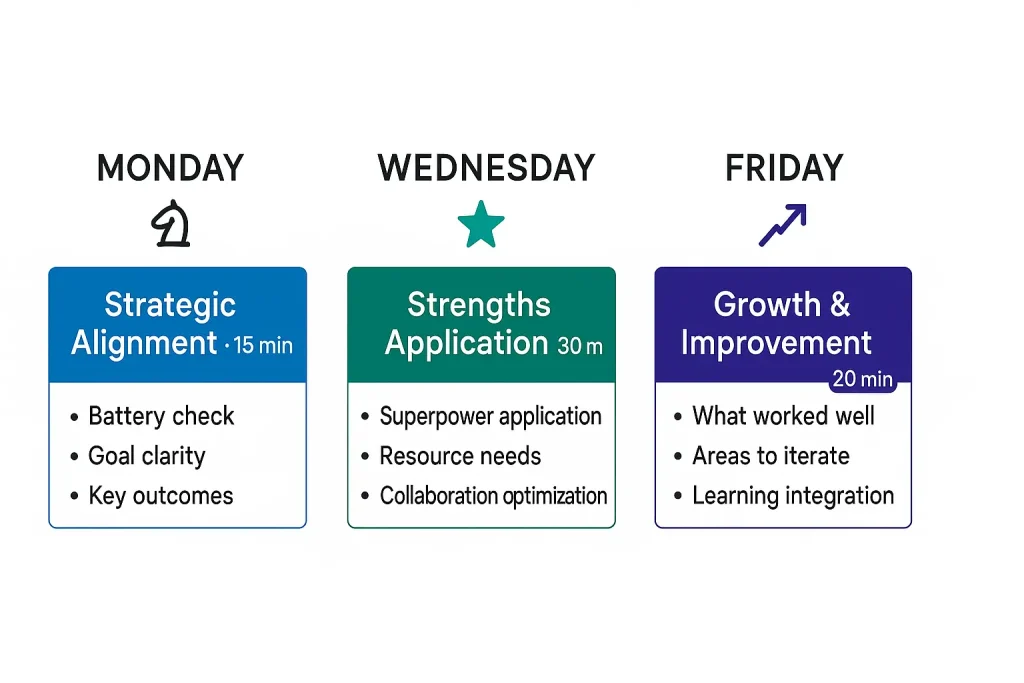
Why Traditional Approaches Fail in Hybrid Environments
The fundamental issue with most hybrid team management approaches: they’re retrofitted from office-based or remote-based models. But hybrid teams face unique challenges that neither pure model addresses.
The Proximity Bias Problem: Remote workers are 36% less likely than their in-office counterparts to feel that their managers are accessible or effective in building connections. This creates different performance standards for the same team.
The Communication Asymmetry: In-office employees can chat in the elevator, get an update from the boss as they come out of a meeting, and even learn from overhearing conversations between two other colleagues. Remote team members rely entirely on structured communication.
The Context Loss: Information flows differently when teams are distributed. Strategic context that would naturally propagate through casual interactions must be deliberately architected.
Most solutions try to replicate office dynamics digitally. The 5-layer framework accepts that a hybrid is fundamentally different and builds new approaches accordingly.
The Revenue Impact of Getting This Right
Quantifying Hybrid Team Management ROI
Let’s talk numbers that matter to your board.
Companies that emphasize soft skills see an 8% reduction in budget losses due to project failures, a 12% decrease in scope creep, and a 7% increase in achieving business goals. These aren’t soft benefits. They’re hard revenue impacts.
The Multiplier Effect Most Executives Miss:
Hybrid teams, when managed correctly, create compound advantages that traditional analysis misses:
Direct Cost Benefits:
• Talent Access Expansion: Global hiring pool vs. local market constraints
• Real Estate Optimization: Reduced office space requirements (average $11,000 per employee savings)
• Retention Cost Avoidance: 67% report reduced anxiety and improved mental health in hybrid settings
Productivity Multipliers:
• Focus Time Optimization: 40 minutes daily commute savings redirected to productive work
• Energy Management: Battery-based task allocation improves output quality by 25-35%
• Strengths Utilization: Teams operating in individual superpowers show 40-60% performance improvements
Revenue Growth Accelerators:
• Decision Speed: High decision latency teams deliver 63% successful projects vs. 18% for poorly skilled teams
• Strategic Execution: Clear goal cascading reduces strategy-to-execution gaps by 45%
• Innovation Capacity: Diverse, globally distributed teams generate 23% more innovative solutions
The Compound Effect Timeline:
Month 1-2: Improved clarity reduces decision paralysis and project delays
Month 3-6: Strengths-based allocation optimizes team output and quality
Month 6-12: Strategic alignment drives measurable business metric improvements
Year 2+: Compound advantages in talent retention, innovation, and market responsiveness
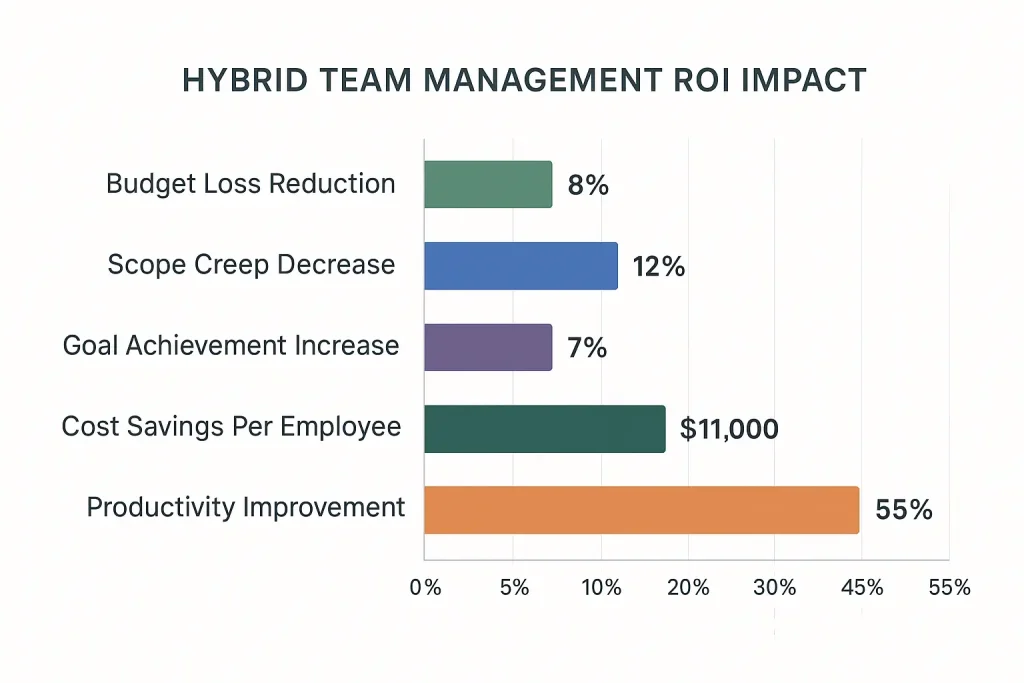
Measuring What Matters:
The ultimate hybrid team management metric: Your core business metric ÷ Total people costs
This could be:
• Revenue per employee cost
• Customer acquisition cost efficiency
• Product development velocity per team investment
• Market expansion rate relative to human capital deployed
When this ratio improves consistently quarter-over-quarter, you’ve successfully implemented hybrid team management at scale.
Implementation Roadmap: Your 90-Day Transformation
IMPLEMENTATION CHECKLIST
Phase 1 (Days 1-30): Foundation Setting
- Week 1: Train managers on the 5-layer framework
- Week 2: Develop team charters using the framework
- Week 3: Launch weekly operating system implementation
- Week 4: Begin initial data collection and baseline establishment
Phase 2 (Days 31-60): Optimization and Iteration
- Weeks 5-6: Individual coaching on strengths identification
- Weeks 7-8: Process refinement based on initial feedback
Phase 3 (Days 61-90): Scaling and Systematization
- Weeks 9-10: Cross-team framework implementation
- Weeks 11-12: Performance metrics analysis and strategy adjustment
Phase 1 (Days 1-30): Foundation Setting
Week 1: Manager training on the 5-layer framework
Week 2: Team charter development using the framework
Week 3: Weekly operating system implementation
Week 4: Initial data collection and baseline establishment
Phase 2 (Days 31-60): Optimization and Iteration
Weeks 5-6: Individual coaching on strengths identification
Weeks 7-8: Process refinement based on initial feedback
Phase 3 (Days 61-90): Scaling and Systematization
Weeks 9-10: Cross-team framework implementation
Weeks 11-12: Performance metrics analysis and strategy adjustment
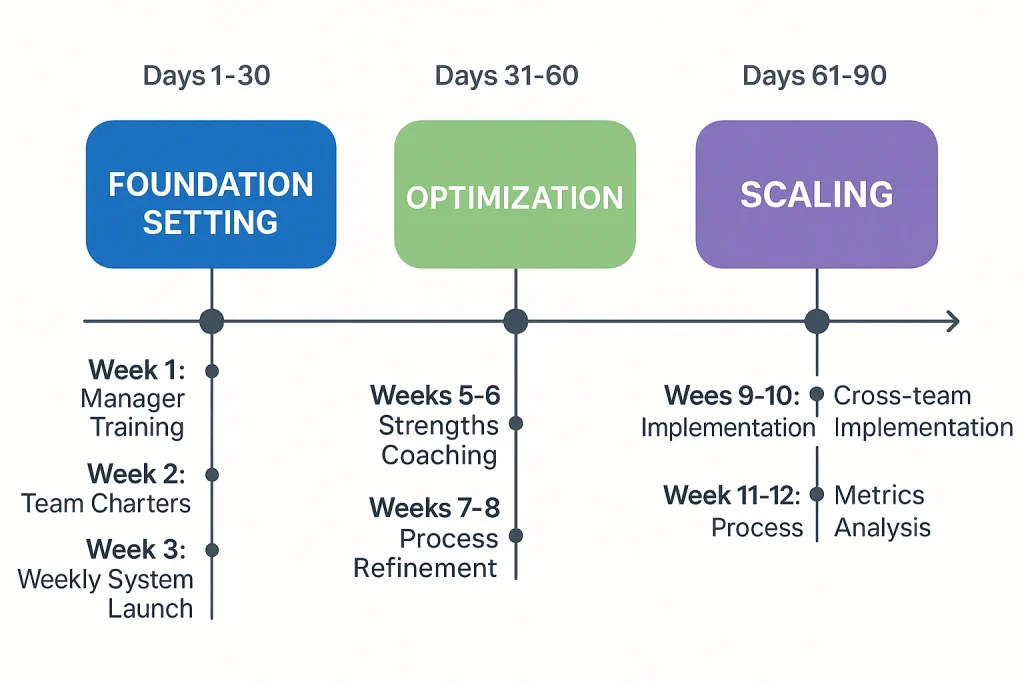
The Technology Architecture You Actually Need
Essential vs. Optional: Your Hybrid Team Tech Stack
Forget the complex platform stacks. The 5-layer framework requires surprisingly simple technology:
Layer 1 – Energy Tracking (Essential):
• Simple daily check-ins (Slack polls, Microsoft Forms, or Google Forms)
• Weekly energy trend reporting
• Battery level visualization tools
Layer 2 – Goal Cascading (Essential):
• Visual alignment tools (Asana, Monday.com, Notion, or Excel/Google Sheets)
• Objective tracking and progress monitoring
• Team-to-individual goal mapping systems
Layer 3 – Feedback Systems (Essential):
• Regular structured feedback loops (15Five, Culture Amp, or structured documents)
• 360-degree feedback collection tools
• Strengths identification and tracking platforms
Layer 4 – Improvement Tracking (Recommended):
• Skill gap analysis tools
• Development plan monitoring
• Performance improvement documentation systems
Layer 5 – Learning Integration (Optional):
• Skill development tracking platforms
• Learning management systems (LMS)
• Application and knowledge retention measurement tools
The Critical Success Factor: The sophistication isn’t in the tools. It’s in the systematic application.
Budget Considerations:
• Minimum viable implementation: $0-50/month using free tools
• Recommended setup: $200-500/month for teams under 50 people
• Enterprise implementation: $1000-3000/month for organizations 200+ people
Integration Requirements: Most successful implementations integrate with existing communication platforms (Slack, Microsoft Teams) rather than requiring separate logins and workflows.
Common Implementation Mistakes That Kill Results
What Kills Hybrid Team Success: The Top 3 Failures
Mistake 1: Treating This as HR’s Problem
Hybrid team management isn’t human resources. It’s business operations. The companies that succeed treat this as a core operational capability, not a policy implementation.
Root Cause: Organizations assign hybrid team management to HR departments because it involves “people issues.” However, HR focuses on compliance, policies, and administrative functions, while hybrid team management requires operational optimization and performance architecture.
Solution: Assign hybrid team management to operations or strategy teams. Make it a business capability, not a people policy.
Mistake 2: Over-Engineering the Solution
The framework works because of its simplicity, not despite it. Organizations that try to customize every element typically fail to implement any element effectively.
Root Cause: Leadership teams want sophisticated solutions that match their complex challenges. They add layers, customize processes, and create elaborate tracking systems that overwhelm managers and teams.
Solution: Implement the framework exactly as designed for 60 days before making any modifications. Simplicity drives adoption, which drives results.
Mistake 3: Focusing on Individual Productivity Instead of Team Performance
Individual productivity metrics miss the point entirely in hybrid environments. Team coordination and collective output matter more than individual time tracking.
Root Cause: Traditional management approaches measure individual contribution. Hybrid teams require collective coordination that doesn’t show up in individual metrics.
Solution: Measure team outcomes, goal completion rates, and collective productivity ratios rather than individual activity levels.
The Future of Hybrid Team Management
EVIDENCE: Gallup finds that having an effective manager leads to four times higher employee engagement and wellbeing, regardless of how often they work remotely.
The organizations that master hybrid team management aren’t just optimizing for today’s distributed workforce. They’re building the operational foundation for the next decade of business competition.
As AI handles more routine cognitive work, human teams will focus increasingly on complex problem-solving, creative collaboration, and strategic execution. These activities require precisely the kind of energy management, strategic clarity, and systematic development that the 5-layer framework provides.
The companies implementing these approaches now will have compound advantages when the competitive landscape shifts even further toward knowledge work optimization.
Watch the Complete Expert Interview

Deep Dive: Scaling Hybrid Teams from Startup to 27,000 Employees
For comprehensive insights into hybrid team management and scaling strategies, watch the full conversation with Projjal Ghatak on the Predictable B2B Success podcast.
This in-depth interview covers advanced topics beyond this framework overview:
Extended Interview Topics:
Scaling Challenges at Uber: How rapid growth from 9,000 to 27,000 employees revealed the critical gaps between business school theory and real-world management practices in distributed environments.
Technology vs. Human Solutions: Why many B2B businesses are forced into software-only solutions too early in their development and how tech-enabled services create superior outcomes for hybrid team challenges.
ROI Measurement in Practice: Practical approaches to measuring team productivity using the business metrics ÷ total people costs formula, with specific examples from different industries.
Strategic Execution: Detailed discussion of how the disconnect between strategy formulation and execution becomes amplified in hybrid environments, plus systematic approaches to bridge this gap.
Industry Evolution and AI Impact: Forward-looking predictions for how AI will reshape knowledge work and why human-centric team management becomes even more critical as automation handles routine tasks.
Real-World Implementation: Specific case studies of companies that successfully implemented Collaborative Team Development approaches, including challenges faced and solutions developed.
Watch the complete interview on YouTube to access the whole conversation and gain additional context behind the 5-layer framework development.
Interview Value for Implementation:
The extended conversation provides practical examples from Ghatak’s experience scaling teams across different industries, geographies, and company stages. These insights prove particularly valuable for executives planning their own hybrid team management transformation.
Your Next Steps: Making This Real
The difference between reading about management frameworks and implementing them successfully comes down to systematic execution and expert guidance.
Suppose you’re running a B2B tech startup (especially in cleantech or environmental services) and want to implement this 5-layer framework systematically. In that case, I help companies create the educational content and leadership communication that makes these transformations stick.
Through ghostwritten educational email courses, I help C-suite leaders communicate strategic clarity throughout their organizations. Through LinkedIn content strategy, I help them build the thought leadership that attracts top hybrid talent.
But more importantly, I help companies avoid the 95% failure rate by implementing systematic approaches like this framework with the right messaging architecture.
The hybrid team management challenge isn’t going away. The question is whether you’ll solve it systematically or continue hoping that flexibility alone creates performance.
The 5-layer framework provides a systematic approach. Your implementation determines the results.
Contact us to discuss how we can help you implement this framework with the right content strategy and leadership communication approach.
Frequently Asked Questions
Q: How long does it take to see results from the 5-layer framework? A: Most companies see initial improvements in team clarity and energy within 2-3 weeks. Full transformation typically occurs within 90 days of consistent implementation.
Q: What’s the difference between hybrid team management and remote team management? A: Hybrid teams face unique challenges that neither remote nor in-office teams experience, including proximity bias, communication asymmetry, and context loss. The 5-layer framework specifically addresses these hybrid-specific issues.
Q: Can this framework work for teams smaller than 50 people? A: Yes, the framework scales from teams of 5 to organizations of 500+. Smaller teams can implement all five layers with simplified tracking and fewer formal processes.
Q: What if my managers resist the weekly touchpoint system? A: Start with the energy and clarity layers only. Once managers see improved team performance, they typically embrace the additional layers. The key is demonstrating ROI before adding complexity.
Q: How does this differ from OKRs or other goal-setting frameworks? A: Unlike OKRs, which are designed organization-first, the 5-layer framework is built individual-first, then aligned upward. It also integrates energy management and strengths-based feedback, which traditional frameworks miss.
Framework Comparison: Traditional vs. 5-Layer Approach
| Element | Traditional OKRs | 5-Layer Framework |
|---|---|---|
| Design Origin | Organization-down | Individual-up |
| Energy Management | Not addressed | Core foundation layer |
| Feedback Approach | Generic improvement | Strengths-based + targeted |
| Success Measurement | Goal completion | Energy + clarity + performance |
| Hybrid Optimization | Location-agnostic | Specifically addresses asymmetric challenges |
Q: What technology do I need to implement this framework? A: The framework requires minimal technology – simple check-in tools, goal tracking systems, and feedback collection methods. Many teams successfully implement it using basic tools like Slack, Asana, or even shared spreadsheets.
Q: How do you measure success with hybrid team management? A: Key metrics include team clarity scores, energy level trends, goal completion rates, and ultimately your core business metric divided by total people costs – the productivity ratio that matters most.
Key Performance Indicators for 5-Layer Framework:
Layer 1 Metrics (Energy Management):
• Average team battery levels (target: 70%+ consistently)
• Energy trend stability (minimal week-to-week variance)
• Task-energy alignment accuracy
Layer 2 Metrics (Strategic Clarity):
• Goal understanding assessment scores (target: 90%+ team comprehension)
• Cascade alignment percentage (individual → team → organization)
• Strategy-to-execution gap measurements
Layer 3 Metrics (Strengths-Based Feedback):
• Superpower identification completion (100% team coverage)
• Strengths utilization in role assignments
• Team satisfaction with strength-based task allocation
Layer 4 Metrics (Targeted Improvement):
• Development plan completion rates
• Skill gap closure timeline adherence
• Performance improvement trajectory tracking
Layer 5 Metrics (Continuous Learning):
• Learning integration application rates
• Skill development ROI measurements
• Knowledge retention and practical application scores
Ultimate Success Metric: Business performance per people cost improvement quarter-over-quarter
About the Framework: This approach combines insights from Collaborative Team Development research, hybrid work productivity studies, and practical implementation across funded B2B tech startups. For systematic implementation support, including educational content creation and leadership communication strategy, learn more about our approach.
Some areas we explore in this episode include:
Listen to the episode.
Related links and resources
- Check out OnLoop
- Learn from Ryan Yackel – Save $1M+ Annually With This Data Observability Hack (And Stop Wasting Resources on Preventable Data Issues.)
- Learn from Ian Harris – How a First Principles Approach Simplifies Growth: Revenue Breakthroughs Made Easy
- Learn from Pete Steege – Small Tests, Big Wins: Iterative Agile Marketing Secrets Revealed
- Check out the article – 4 Key Strategies for Driving B2B Sales Growth in 2025
- Check out the article – Real Time Marketing: How to Make the Most of Every Moment
Connect with Projjal Ghatak
Subscribe to & Review the Predictable B2B Success Podcast
Thanks for tuning into this week’s Predictable B2B Podcast episode! If the information in our interviews has helped your business journey, please head over to Apple Podcasts, subscribe to the show, and leave us an honest review.
Your reviews and feedback will not only help me continue to deliver great, helpful content but also help me reach even more amazing founders and executives like you!

 Why 90% of Technical Partnership Outsourcing Fails (Data-Driven Analysis)
Why 90% of Technical Partnership Outsourcing Fails (Data-Driven Analysis)
Leave a Reply